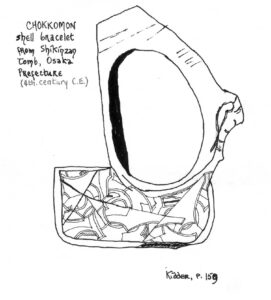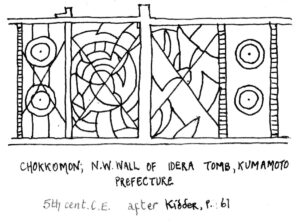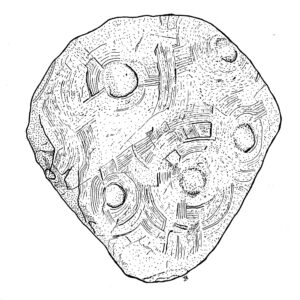A curious feature of a number of Japanese artefacts and funerary sites of the Kofun period (c.250-600 CE), particularly the 4th century, is a fragmented design based on spiral geometry, known as the chokkomon. John Billingsley introduced this design and its deployment in liminal contexts to aficionadoes of mazes and labyrinths in the 1980s (hence the ‘handmade’ quality of the illustrations…).
Looking at the Chinese language equivalents for maze, labyrinth and spiral suggests that, apart from the movement pattern indicated in the Taoist diagrams featured in Caerdroia 11, there may be little in E Asia directly comparable with patterns in other parts of the world, outside of small mystery societies of spiritual origin. The word for maze translates as ‘confusing or troublesome path’; labyrinth is more promising, as a ‘confusing shrine or palace’, but this turns out to be modern Chinese derived from the Minotaur legend of Crete, indicating that there has not been a prior generally-known concept of that nature in Chinese culture. The word for spiral means ’round and round like a snail shell’, and all associated terms that I could track down are similarly drawn from the image of the shell of the snail or similar creature.
Yet there exist the diagrams shown in Caerdroia 11, p32, demonstrating that there was at least a Taoist concepption of spiral movement in past times, and the Taoist conception of the Subtle Alchemy of the body as possessing three centres of energy has been artistically expressed as a triple spiral. In fact, an almost identical picture to the lower of the two in Caerdroia 11 (Oct. 1982) may be found in Rawson and Legeza’s Taoism (Thames & Hudson 1973). Plate 53 in this work reveals the initiate at the entrance to a spiral configuration attending to the Great Bear constellation, only this time he is surrounded by what appear to be waves. The picture is dated to 1886. The position occupied by the spiral is the ‘Middle Gate’ of the spine, associated with the moving force of the body, by which a person attunes to the movement of the Tao.
Much of Japanese culture has been borrowed wholesale from the Asian mainland, particularly in the historical period from China (even earlier, from Korea), and this includes the kanji ideographic script of the Japanese language (though the two languages are linguistically and grammatically quite different). The opening remarks above therefore apply equally, as far as we can tell, to Japanese language and culture. Vigorous shamanistic traditions among the Japanese peoples, however, predate Chinese and possibly even Korean influences, but are unscriptured and have been absorbed into folk life largely as mediumistic experience. Comparable evidence with European labyrinth styles, if any exists, may be extremely difficult to find.
Yet the spiral has had one development peculiar to Japan, and one that is associated almost exclusively with funerary contexts. Early designs inside stone tombs of the Kofun period (c250-600 CE) show concentric circles which my be traced to Korean and Han Chinese prototypes. Also around this time ceremonial bronze mirrors, usually imported from China, were incorporated into funerary customs, and designs on these mirrors are spiral-related. From the 4th century CE on, however, Japanese tomb paraphernalia include a complex design which has never been satisfactorily interpreted; some examples are illustrated here. This design is known as the chokkomon (straight and round pattern), and generally has a spiral basis. No two patterns are alike; they are not random, however, but apparently follow a combination of fixed motifs in various dispositions, including inversion and sub-division. They can be classified into three types:
Type A:
“crossing diagonal lines over which a fragmentary spiral appears to be superimposed, and the spaces formed by these intersecting lines are themselves reduced to irregular sizes by more or less radial lines”
Type B:
“is still spun around the basic diagonal axes, but is minus the fractured spiral. The design has more open spaces, and is, in effect, less forcefully rhythmical, lacking the rotary motion”
Type C:
“combines elements of A and B”.[1]
The shell bracelet illustrated (Fig. 1) is one of the oldest examples found, dating to the 4th century CE or earlier, and later examples and variations develop along the rotary theme. An associated motif is without doubt the ‘binding’ pattern shown in various of its forms in Fig. 2, and the fiuigure depicts some traceable derivations which accompanied the spread of the chokkomon eastward from Yamato to Kibi [2] during the 5th century CE. In this progression the chokkomon moved into its ‘rotary’ phase, as shown in Fig. 3, also from Kibi; and in the same century, the motif reached the great sophistication of the tombs of modern Kumamoto Prefecture in Kyushu, most notably the Idera Tomb (Fig. 4; note also the motif of the concentric circles, aka sun dics, which were alternated between chokkomon designs.[3]
 Fig. 1
Fig. 1  Fig. 2
Fig. 2
 Fig. 3
Fig. 3
The chokkomon is invariably associated with inanimate objects, never appearing on human figures, and bears without doubt profound esoteric significance. As I have noted above, however, precisely, or even roughly, what significance that may be is still a matter of conjecture. Suggestions have brought in associations such as deformed Chinese characters, weaving and belt designs, and one scholar suggested the pattern was held to possess an ability to calm the spirits of the dead (cf. shizume-ishi), but none of these appear to reach the heart of the matter. Kidder is a little dismissive of the sophistication, or rather of the manner in which it was attained, but notes the Japanese tendency to abstraction and the production of geometric designs in the native development of imported features, and interprets the chokkomon in that light, as “an abstract form of the Dome of Heaven” derived from Chinese cosmology (cf starmaps of Takamatsuzuka and Kitora tombs of Asuka). He considers it the supreme contribution of Japanese Proto-historic art, the art of a transition from a shamanistic pagan culture to the unified and centralised hierarchical state that took the country into its Historical period. There may also be some magical significance in that these fragmented designs moved across the country as the powerful Yamato clan subdued its opponents, some of which at least were connected with terrestrial spiritual and funerary traditions, including local geomantic systems of terrestrial alignments.[4] Japanese myths hint that the Yamato’s spiritual attitudes were subsequently imposed politically and religiously upon the subdued territories.
I regret I can offer no real conclusion to this look at a particular development of the spiral motif in Japan, and so these words can only be considered as an introduction to a topic highly unfamiliar in the West.

Chokkomon design on omphalos stone at Tatetsuki Stone Circle (5th century CE), Okayama
Notes
1 From J Edward Kidder, Early Japanese Art, Thames & Hudson 1964. This book provided the basis for the ensuing notes.
2 Yamato and Kibi are the old names roughly corresponding to the Osaka-Nara (Kansai) area and Okayama Prefecture respectively.
3 A ritual for driving away evil spirits and influences is the making of a ring of miscanthus leaves, and brandishing it in a circular motion, a tradition that Kidder believes (p132) may account for one category of circles in tomb paintings. [postscript 2020: Large rings of miscanthus are also erected at some shrines for people to step through as a purifying ritual. And the chokkomon can also be seen as a ‘mesh’ type of apotropaic sigil, which is perhaps reinforced by its accompaniment of circles around the coffin in tombs.]
4 J Billingsley & A Kuroda, ‘Japanese Earth Mysteries’, The Ley Hunter 92. Note the Tatetsuki stone, which is decorated with a chokkomon pattern, above.
Published in Caerdroia 12, April 1983, pp8-10. https://www.labyrinthos.net/caerdroiaarchive.html